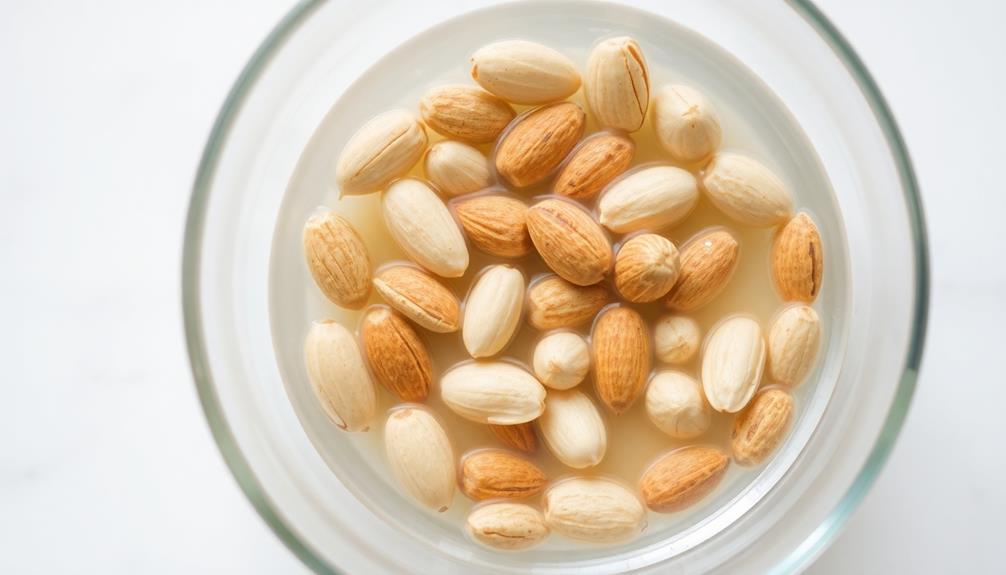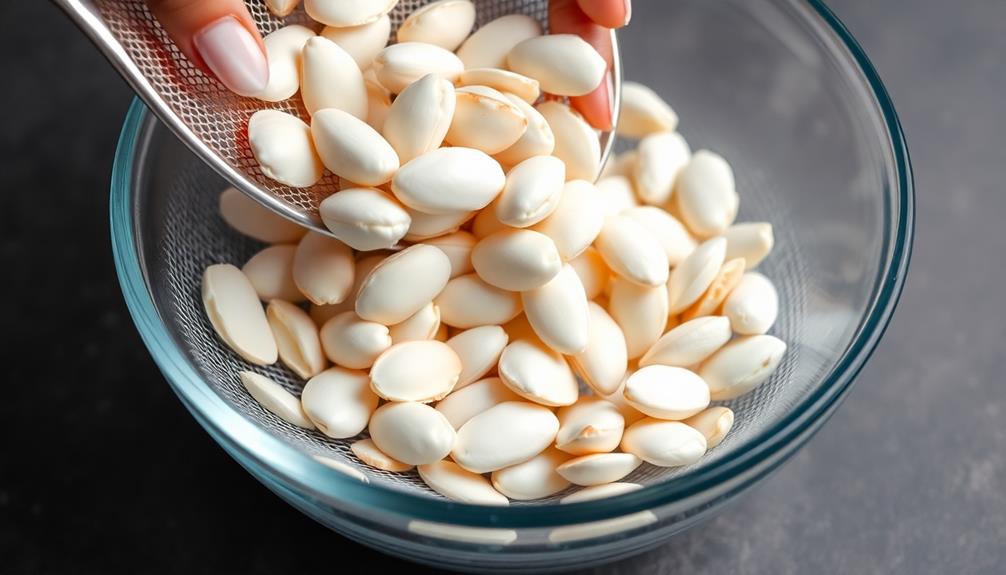Ajo Blanco is a refreshing cold soup that originated in southern Spain, influenced by Moorish culture. This traditional dish features a creamy blend of toasted almonds, garlic, bread, and olive oil – perfect for serving during hot summer months. Often paired with seasonal fruits like grapes, Ajo Blanco is a staple at local festivals, showcasing Spain's rich culinary heritage. To make this chilled soup, you'll soak the almonds, blend the ingredients, and chill it for a few hours. Top it with toasted almond slivers and fresh herbs for a visually appealing presentation. Curious to learn more about this unique Spanish specialty? Keep reading for a closer look at the recipe and cooking steps.
Key Takeaways
- Ajo Blanco is a traditional chilled Spanish soup originating from the Andalusia region, known for its unique blend of toasted almonds, garlic, bread, and olive oil.
- The soup is typically served as a refreshing appetizer or light main course during hot summer months and is a staple at local festivals.
- The main ingredients in Ajo Blanco include blanched almonds, garlic, day-old bread, olive oil, and sherry vinegar, which are blended to create a creamy, pourable consistency.
- Ajo Blanco can be customized with additions like grapes, melon, or cucumber, and is often garnished with toasted almond slivers and fresh herbs for presentation.
- Ajo Blanco is a nutritious dish, rich in healthy fats from almonds and olive oil, low in calories, and provides a good source of protein and vitamins.
History
Although the exact origins of Ajo Blanco are unclear, it's believed to have first emerged as a traditional dish in the southern regions of Spain. This cool, creamy soup has been enjoyed for centuries, with its roots tracing back to the Moorish influence in the Iberian Peninsula.
As the name suggests, Ajo Blanco is made primarily with garlic, or "ajo" in Spanish. The dish also features almonds, bread, olive oil, and vinegar, creating a harmonious blend of flavors.
During the hot summer months, Ajo Blanco provided a refreshing and nourishing meal for laborers and farmers in the countryside.
Today, Ajo Blanco remains a beloved part of Spanish culinary heritage, particularly in the Andalusia region. It's commonly served as an appetizer or light main course, often accompanied by grapes or other seasonal fruits.
The creamy, garlicky soup has become a staple at local festivals and celebrations, showcasing the rich cultural traditions of this unique Spanish dish.
Recipe
Ajo Blanco is a chilled Spanish soup that originated in the Andalusia region. This refreshing, creamy concoction is a perfect summer dish, offering a delightful balance of tangy, nutty, and garlicky flavors. The traditional recipe calls for a simple blend of toasted almonds, garlic, olive oil, bread, and vinegar, resulting in a velvety, cool soup that's both nourishing and indulgent. Ajo Blanco is often garnished with grapes and sliced almonds for an extra burst of sweetness and crunch. This dish is a staple in many Spanish households and is often served alongside other traditional Spanish dishes like paella and Spanish omelette recipe. Its simplicity and versatility make it a popular choice for entertaining or a light, yet satisfying, meal.
Ajo Blanco is a versatile dish that can be customized to suit individual tastes. While the classic version is delicious on its own, some variations may include the addition of grapes, melon, or cucumber, adding a touch of sweetness and crunch to the soup.
Ingredients:
- 1 cup blanched almonds
- 3 cloves of garlic, peeled
- 1/2 cup diced day-old bread (without crust)
- 1/4 cup extra-virgin olive oil
- 2 tablespoons sherry vinegar
- 2 cups cold water
- 1/2 teaspoon sea salt
To prepare the Ajo Blanco, begin by toasting the almonds in a dry skillet over medium heat until fragrant and lightly browned. Allow to cool, then transfer to a food processor or high-powered blender.
Add the garlic, bread, olive oil, vinegar, water, and salt. Blend until the mixture is smooth and creamy, about 2-3 minutes.
Chill the Ajo Blanco for at least 2 hours before serving. This allows the flavors to meld and the soup to reach the perfect temperature.
Serve the chilled soup garnished with toasted almond slivers, a drizzle of olive oil, and a sprinkle of fresh herbs, such as chives or parsley, if desired. Enjoy the refreshing and flavorful Ajo Blanco on a warm summer day.
Cooking Steps
First, you'll want to soak the almonds for several hours.
After that, strain and discard the almond skins.
Then, blend the soaked almonds with garlic and add in some vinegar.
Don't forget to chill the mixture before serving this delightful dish.
Step 1. Soak Almonds for Several Hours

Begin by soaking the almonds for several hours. This is a crucial first step in making the classic Spanish cold soup, ajo blanco. Submerge the almonds in water and let them soak for at least 3 to 4 hours, or even overnight. This helps soften the nuts, making them easier to blend into a smooth, creamy texture later on.
During the soaking process, the almonds will absorb water and plump up. This hydration is essential for achieving the desired consistency of the ajo blanco.
Once the almonds have soaked, drain and rinse them thoroughly. They're now ready to be combined with the other key ingredients – garlic, bread, olive oil, and sherry vinegar – to create the refreshing, garlicky soup.
The soaked almonds will blend seamlessly into the mixture, lending their nutty flavor and luxurious creaminess to the ajo blanco. This simple prep work sets the stage for the delicious cold soup to come.
Step 2. Strain and Discard Almond Skins

After draining and rinsing the soaked almonds, it's time to remove their skins.
Grab a clean kitchen towel and place the almonds on it. Gently rub the almonds between the towel, applying light pressure. This should cause the skins to slip off easily.
Once an almond is peeled, simply discard the skin. Continue this process until all the almonds have been skinned.
Be careful not to press too hard, as you don't want to crush the almonds. The peeled almonds will have a smooth, pale appearance.
Discard the almond skins, as they won't be used in the ajo blanco recipe. This step helps create a creamy, velvety texture in the final dish.
With the almonds now skinned, you're ready to move on to the next step in making this delicious cold Spanish soup.
Step 3. Blend Soaked Almonds With Garlic

Once the almonds have been peeled, you'll need to blend them together with garlic to create the foundation for the ajo blanco.
In a food processor or high-powered blender, add the soaked and drained almonds along with 2-3 cloves of peeled garlic. Pulse the mixture until it forms a smooth, creamy paste. You may need to stop and scrape down the sides a few times to ensure everything is evenly incorporated.
The blended almond-garlic mixture will have a rich, nutty aroma that fills the air. Be sure to taste it and adjust the garlic to your liking, adding more if you prefer a stronger flavor.
This thick, velvety base will provide the essential texture and taste for the final ajo blanco soup. With the almonds and garlic now blended, you're ready to move on to the next step: thinning the mixture with broth or water.
Step 4. Add Vinegar

The next step is to add vinegar to the blended almond-garlic mixture. This sour element helps to balance the richness of the almonds and the pungency of the garlic.
Pour in a few tablespoons of sherry vinegar or white wine vinegar and stir it in gently. The vinegar will react with the other ingredients, creating a bright, tangy flavor that brightens up the creamy base.
Taste the mixture and add more vinegar if you'd like a more pronounced acidity. You can also experiment with different types of vinegar to find your preferred flavor profile. Just be sure to start with a small amount and gradually increase until you reach the perfect balance.
The vinegar will help to thin out the texture of the ajo blanco as well, making it more pourable and smooth.
After incorporating the vinegar, you're ready to move on to the next step of seasoning the soup with salt and pepper to taste. This simple addition of vinegar really helps to elevate the flavors and bring the ajo blanco together.
Step 5. Chill Mixture Before Serving

With the vinegar now incorporated, chill the ajo blanco mixture before serving. This creamy, chilled soup is best enjoyed after it has had time to cool in the refrigerator.
Pour the mixture into a large serving bowl or individual bowls, then place it in the fridge for at least 2 hours, or until it's thoroughly chilled.
Chilling the ajo blanco allows the flavors to meld and the texture to become delightfully smooth and velvety. The cold temperature also helps to balance the richness of the olive oil and almonds.
Before serving, you may want to give the mixture a gentle stir to ensure an even temperature throughout.
Once chilled, the ajo blanco is ready to be enjoyed. Ladle it into bowls and top with any desired garnishes, such as toasted almond slivers, fresh grapes, or a drizzle of high-quality olive oil.
The cool, creamy soup is a refreshing and flavorful start to any summer meal.
Final Thoughts
Ajo Blanco, the captivating Spanish chilled almond soup, has undoubtedly captured the hearts and palates of food enthusiasts worldwide. This delectable dish's simplicity and versatility make it a must-try for anyone seeking a refreshing and flavorful summer treat.
Whether you're hosting a backyard gathering or simply craving a cool, creamy delight, Ajo Blanco is the perfect choice.
As you savor the final spoonfuls of this delightful soup, you can't help but appreciate the harmony of flavors and textures. The silky smooth texture, the crunch of toasted almonds, and the bright acidity of the wine vinegar come together in perfect harmony.
It's a culinary experience that lingers in your memory, leaving you eager to recreate this Spanish gem in your own kitchen.
Frequently Asked Questions
Is Ajo Blanco Suitable for Vegans and Vegetarians?
Yes, ajo blanco is suitable for vegans and vegetarians. It's a chilled Spanish almond and garlic soup that doesn't contain any animal products, making it a perfect plant-based option for those following a vegan or vegetarian diet.
How Long Does Ajo Blanco Typically Last When Stored Properly?
When stored properly, ajo blanco typically lasts 3-5 days in the refrigerator. It's essential to keep it chilled and covered to preserve the fresh flavors and prevent spoilage.
Can Ajo Blanco Be Served Warm or Should It Always Be Chilled?
You can serve ajo blanco warm or chilled, depending on your preference. While it's often served cold, the dish can be enjoyed at room temperature or even slightly warmed, allowing the flavors to mingle and shine.
Are There Any Variations or Alternatives to the Traditional Ajo Blanco Recipe?
There are a few variations and alternatives to the traditional recipe. You can add fruits like grapes or apples, experiment with different nuts, or even make a creamy version by blending in avocado.
What Are the Health Benefits of Consuming Ajo Blanco?
Consuming ajo blanco can provide several health benefits. It's rich in antioxidants, which can help boost your immune system and reduce inflammation. The garlic and nuts in ajo blanco also contain compounds that may support heart health and improve digestion.










